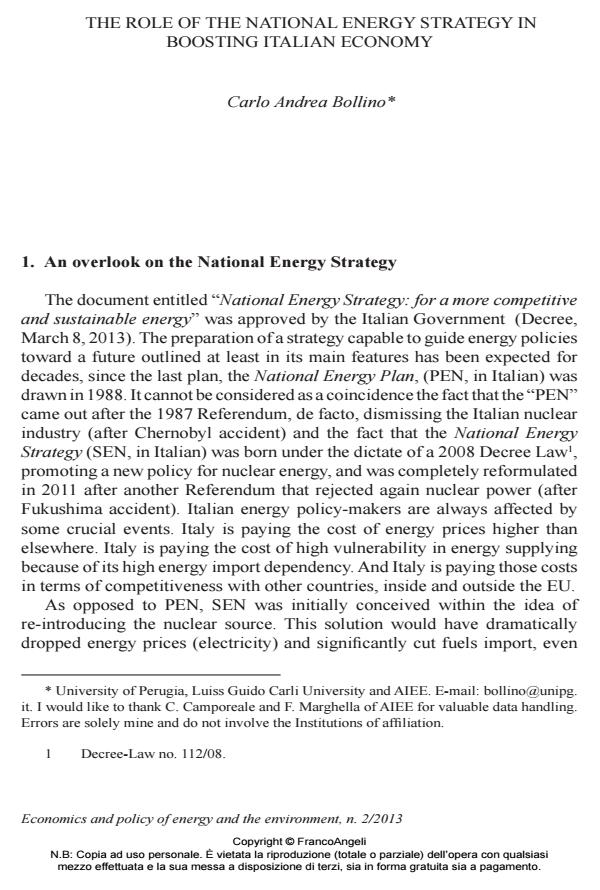The role of the National Energy Strategy in boosting italian economy
Titolo Rivista ECONOMICS AND POLICY OF ENERGY AND THE ENVIRONMENT
Autori/Curatori Carlo Andrea Bollino
Anno di pubblicazione 2013 Fascicolo 2013/2
Lingua Inglese Numero pagine 20 P. 19-38 Dimensione file 865 KB
DOI 10.3280/EFE2013-002002
Il DOI è il codice a barre della proprietà intellettuale: per saperne di più
clicca qui
Qui sotto puoi vedere in anteprima la prima pagina di questo articolo.
Se questo articolo ti interessa, lo puoi acquistare (e scaricare in formato pdf) seguendo le facili indicazioni per acquistare il download credit. Acquista Download Credits per scaricare questo Articolo in formato PDF

FrancoAngeli è membro della Publishers International Linking Association, Inc (PILA)associazione indipendente e non profit per facilitare (attraverso i servizi tecnologici implementati da CrossRef.org) l’accesso degli studiosi ai contenuti digitali nelle pubblicazioni professionali e scientifiche
I analyze the new energy strategy approved by the Italian Government, the "National Energy Strategy: for a more competitive and sustainable energy". One of the SEN medium term targets is the equalization of Italian energy prices to the EU average within 2020. I argue that it is true that electricity market prices in Italy are effectively higher than in other EU Member States due to the fact that Italian generation mix is skewed toward expensive sources, like natural gas. However, system charges and taxes affect in a peculiar way households and industry final prices. In particular, I document that Italian industrial prices are higher than corresponding German price. However, Italian household prices are lower than corresponding German price. I set forth a new plausible proposal not considered in SEN, aimed at spurring competitiveness and growth of the Italian economy, adopting the relative electricity market prices structure similar to that registered in German market in 2012. I propose to shift electricity taxes and general system charges from Italian industry resulting in a 8% reduction of their final price, to Italian households resulting in a 24,5% increase of their final price. keeping the overall system of charges and taxes in monetary equilibrium. The macroeconomic effect of this policy on the Italian economy (using recently estimated elasticities for the Italian energy sector) will be the sum of the aggregate positive effect on industry and services, of about 2.2%, which constitute four fifths of total Italian value added plus the (smaller) negative effect on households spending of about -0.4%. The final effect can reach an order of magnitude of about 2% contribution to GDP growth. From a political viewpoint, this would also mean to make clear to the individual citizen that there exists a trade-off between a base scenario of paying less the electric bill and witness economic stagnation and unemployment and a more aggressive policy scenario of paying more the electric bill and witness some higher economic growth and lower unemployment.
Parole chiave:Italian National Energy Strategy, electricity prices, electricity system charges and taxes, increase competitiveness
Jel codes:D20 E27 Q40 Q48
- The applicability of the indicators proposed by the European and national regulatory framework to the Energy and Environmental Masterplan of the Sicilian Region. Luana Filogamo, in ECONOMICS AND POLICY OF ENERGY AND THE ENVIRONMENT 1/2014 pp.145
DOI: 10.3280/EFE2014-001007
Carlo Andrea Bollino, The role of the National Energy Strategy in boosting italian economy in "ECONOMICS AND POLICY OF ENERGY AND THE ENVIRONMENT" 2/2013, pp 19-38, DOI: 10.3280/EFE2013-002002